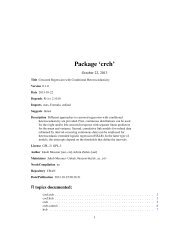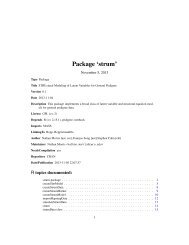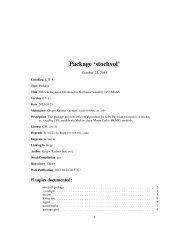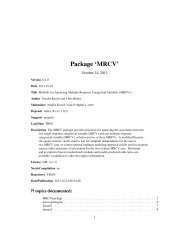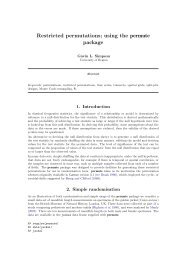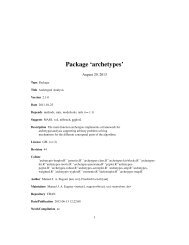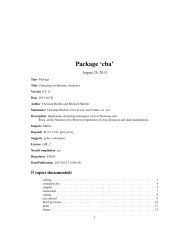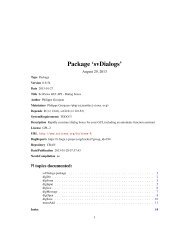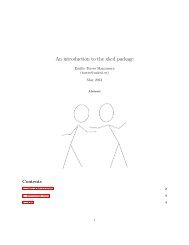You also want an ePaper? Increase the reach of your titles
YUMPU automatically turns print PDFs into web optimized ePapers that Google loves.
30 predict.averaging<br />
Description<br />
Usage<br />
Model-averaged predictions with optional standard errors.<br />
## S3 method for class ’averaging’<br />
predict(object, newdata = NULL, se.fit = FALSE,<br />
interval = NULL, type = NA, backtransform = FALSE, full = TRUE, ...)<br />
Arguments<br />
Details<br />
object An object returned by model.avg.<br />
newdata An optional data frame in which to look for variables with which to predict. If<br />
omitted, the fitted values are used.<br />
se.fit logical, indicates if standard errors should be returned. This has any effect only<br />
if the predict methods for each of the component models support it.<br />
interval Currently not used.<br />
type The type of predictions to return (see documentation for predict appropriate<br />
for the class of used component models). If omitted, the default type is used.<br />
See ‘Details’.<br />
backtransform If TRUE, the averaged predictions are back-transformed from link scale to response<br />
scale. This makes sense provided that all component models use the<br />
same family, and the prediction from each of the component models is calculated<br />
on the link scale (as specified by type. For glm, use type = "link"). See<br />
‘Details’.<br />
full If TRUE, the full model averaged coefficients are used (only if se.fit = FALSE<br />
and the component objects are a result of lm).<br />
... Arguments to be passed to respective predict method (e.g. level for lme<br />
model).<br />
If all the component models are oridinary linear models, the prediction can be made either with<br />
the full averaged coefficients (the argument full = TRUE this is the default) or subset-averaged<br />
coefficients. Otherwise the prediction is obtained by calling predict on each component model<br />
and weighted averaging the results, which corresponds to the assumption that all predictors are<br />
present in all models, but those not estimated are equal zero. See ‘Note’ in model.avg. Predictions<br />
from component models with standard errors are passed to par.avg and averaged in the same way<br />
as the coefficients.<br />
Predictions on the response scale from generalized models can be calculated by averaging predictions<br />
of each model on the link scale, followed by inverse transformation (this is achieved with<br />
type = "link" and backtransform = TRUE). This is only possible if all component models use<br />
the same family and link function. Alternatively, predictions from each model on response scale<br />
may be averaged (with type = "response" and backtransform = FALSE). Note that this leads<br />
to results differing from those calculated with the former method. See also predict.glm.



